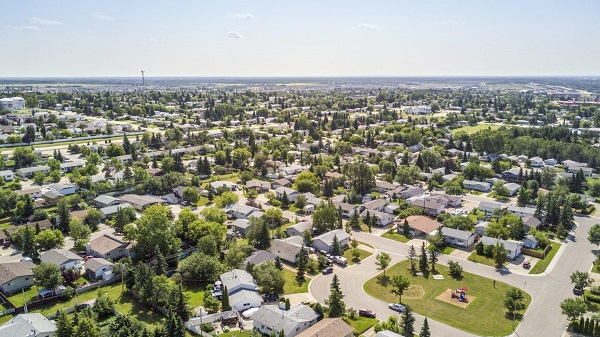Elena Secara is planning a career change. And not a minor change. She’s planning on moving to a different country for the next stage of her working life.
Secara arrived with her husband and their two sons as immigrants from Romania in 2005. At that time, Canada was looking for good-quality newcomers to welcome and Romania was still struggling to pull itself out of the doldrums following its 1989 revolution. As an impressively educated couple – Elena was a bank economist while her husband Gabriel had trained as a mechanical engineer – who were both fluent in French, the Secaras’ prospects looked good. They landed in Montreal, eventually settling in the suburb of Vaudreuil in 2010.
 “The quality of life is low here”: After 20 years of living and working in Canada, Romanian immigrants Elena Secara and her husband Gabriel are planning to move back to their home country, having grown disillusioned with Canada’s economic limitations. (Source of photo: Courtesy of Elena and Gabriel Secara)
“The quality of life is low here”: After 20 years of living and working in Canada, Romanian immigrants Elena Secara and her husband Gabriel are planning to move back to their home country, having grown disillusioned with Canada’s economic limitations. (Source of photo: Courtesy of Elena and Gabriel Secara)
But life in Canada never became quite what they had hoped. Elena could not find the kind of work she thought she would. She took a job as a business manager in a car dealership in 2006, where she has stayed on, while Gabriel hit the wall erected by many Canadian professional associations that often severely limits recognition of education and training in other countries. He took upgrading courses to have his professional degree recognized, but that still didn’t land him a job in his field. Gabriel eventually went to work in manufacturing, often pulling night shifts.
“We had to face the reality of economic life in Canada,” says Elena in an interview. “We have contributed and worked for 20 years in Canada. I have never been without a job. But with the income we can count on over the next few years, it does not allow us to live at a level we wish to live at. The quality of life is low here, and we cannot take it.” Elena became a Canadian citizen in 2009 but she’s planning to say goodbye to Canada in the next couple of years. One of her sons has already voted with his feet, and is now living in Romania.
The Secaras’ story is not unique. Every year tens of thousands of Canadians pull up stakes and start a new life elsewhere. They become emigrants, and their numbers have been rising. Recent debates over the Justin Trudeau government’s massive increase in immigration targets (which last month were scaled back a bit) have ignored the fact that about 100,000 people have been leaving Canada every year of late, undermining the very system the government is so keen to tout and costing the country some of its best and brightest. Many are like Elena – successful people who came to Canada, made it through the immigration system to become citizens, only to feel their ambitions were stymied and their dreams dashed, to grow disillusioned and, ultimately, to leave again.
For many, Canada is not the promised land, or even the type of country they thought it was.
The Outflow by the Numbers
 While it is known that the flow of emigrants from Canada is increasing – and that the number-one destination is the United States – their exact number is elusive, so Canada estimates figures using data from international sources, including the U.S. Department of Homeland Security. (Source of photo: U.S. Customs and Border Protection)
While it is known that the flow of emigrants from Canada is increasing – and that the number-one destination is the United States – their exact number is elusive, so Canada estimates figures using data from international sources, including the U.S. Department of Homeland Security. (Source of photo: U.S. Customs and Border Protection)
The first thing that becomes obvious when looking at emigration is how imprecise the data is. Unlike more repressive regimes, or even the European Union, Canada has no exit controls. Emigrants can just leave – and Canadians can also take their money with them, as long as they pay their taxes – and so organizations like Statistics Canada can only make estimates. “Emigration is one of the most difficult flows [of people] to measure,” says Lorena Canon, an analyst at Statcan who studies migration, in an interview. She and other statisticians have to work with different sources of information, like tax records, lists of recipients of child welfare money, and foreign government agencies that keep records. “Because we know almost all [Canadian emigrants] go to the states, we use data from the U.S. Department of Homeland Security [on new arrivals to the U.S.],” she points out by way of example.
In a 2022 study entitled The Canadian diaspora: Estimating the number of Canadians citizens who live abroad, Canon and her co-author Julien Bérard-Chagnon acknowledged the lack of precision. “The numerous challenges associated with accurately measuring emigration and the significant conceptual differences in international data mean that the few sources that are currently available…provide very different numbers,” they write, in the bureaucratese of number-crunchers. Their study sorts through and analyzes the available data to estimate the number of Canadians living abroad in 2016 at between 2.9 million and 5.5 million, with a “medium numbers scenario” putting it at 4,038,700.
These are big numbers, the “medium” scenario equating to about 12.6 percent of the Canadian population that year (the latest for which this kind of analysis exists). Even if one excluded what the authors call “Canadian citizens by descent” – those born abroad to parents holding Canadian citizenship, who might be thought less connected to Canada – the country has still lost about 2 million citizens who used to live here. (The other two emigrant sub-categories are Canadian-born citizens, who comprise an estimated 33 percent of the nation’s global diaspora, and naturalized citizens, the remaining 15 percent.)
 A 2022 Statistics Canada study put the number of Canadian citizens living abroad in 2016 under its “medium numbers scenario” at roughly 4 million, or 12.5 percent of the national population. (Sources: (table) Statistics Canada, 2022; (chart data) Statistics Canada, 2024)
A 2022 Statistics Canada study put the number of Canadian citizens living abroad in 2016 under its “medium numbers scenario” at roughly 4 million, or 12.5 percent of the national population. (Sources: (table) Statistics Canada, 2022; (chart data) Statistics Canada, 2024)
And given that Canon advises there’s a margin of error of “perhaps up to 5 or 10 percent” in estimating numbers, and the fact – untracked by Statcan – that there are likely Canadian expats working illegally abroad who may not want to be counted, these are likely to be conservative estimates.
The numbers have also been rising in recent years. In its work analyzing the components of population growth, Statcan estimates the number of “emigrants” and “net emigrants” (which subtracts returnees) going back to the 1970s. Both numbers gradually rose into the 1990s, then stabilized to some degree. Emigration jumped significantly in 2016-2017, coinciding with a change in how Statcan calculates its figures. Since 2021-2022 it has been rising steadily, and in 2023-2024 more than 104,000 people left Canada.
Although it’s true that for centuries emigrants tended to be poor, landless people desperate for a better life, or were fleeing oppression or famine, it’s not always the case today and certainly does not describe most Canadians currently pulling up stakes.
Numbers from other sources tell a similar story. This year’s American Community Survey (ACS), conducted by the U.S. Census Bureau, put the number of people moving from Canada to the U.S. at 126,340 in 2022, up by 70 percent from a decade ago. About one-third of those are Americans who were returning home, but the number of Canadian-born immigrants to the U.S. was 50 percent higher than in pre-Covid times.
The Flow of Money, the Flow of People
A realistic interpretation of emigration numbers would include an observation of some historical trends. Although it’s true that for centuries emigrants tended to be poor, landless people desperate for a better life, or were fleeing oppression or famine, it’s not always the case today and certainly does not describe most Canadians currently pulling up stakes. In developed nations, the more prosperous people are typically the more mobile, and with rising wealth come greater means to move to other places.
 Follow the money: Alex Whalen, an economist at the Fraser Institute, believes that “the precipitous decline in earnings [in Canada], relative to the U.S.” is helping drive Canadian emigration.
Follow the money: Alex Whalen, an economist at the Fraser Institute, believes that “the precipitous decline in earnings [in Canada], relative to the U.S.” is helping drive Canadian emigration.
The trend also very likely reflects the globalization of commerce; as more people find themselves working for transnational corporations, they increasingly see the benefits in moving abroad. This is complemented by our era’s instant access to detailed information about nearly any place, even the world’s remotest and most obscure corners. That includes real estate prices, quality of schools, leisure activities – and, among the most important categories, tax levels. More and more Canadians have gained awareness that many other countries offer not only a more pleasing climate than Canada but an equal or better quality of life and some combination of lower taxes and lower prices.
When historians are discussing major past events – like a lot of people moving around – the conversation usually includes discussion of economic circumstances. Put bluntly, find the flow of money and you can explain the flow of people. Alex Whalen, an economist and director of Atlantic Canada Prosperity for the Fraser Institute, points to the earnings gap between Canada and the U.S. as a factor driving current emigration. Its recent report, Our Incomes Are Falling Behind: Earnings in the Canadian Provinces and US States, 2010-2022, compared median per capita earnings in all 50 U.S. states and 10 Canadian provinces – and painted a depressing picture. Results in 2010 were worrisome enough: Alberta was the only Canadian province in the top 20. By 2022, all 10 Canadian provinces finished at the bottom of the ranking. Every province had become poorer, by that measure, than the lowest-earning American state.
“The precipitous decline in earnings, relative to the U.S. is deeply concerning, but not entirely surprising,” says Whalen in an interview. Canadian incomes have been lower than those in the U.S. for some time, he says, but it’s the dramatic nature of their recent relative decline that’s raising eyebrows. And it is not just relative to the U.S. Whalen points to growth rates in per capita gross domestic product (GDP) – how much a country produces per person – as evidence of Canada’s waning economic power. In another recent study, the Fraser Institute noted that Canada ranked third-lowest among 30 OECD countries by that measure between 2014 and 2022, losing ground to key allies and trading partners like the U.S., U.K. and Australia.
 Comparing median per capita earnings in 50 U.S. states and the 10 Canadian provinces in 2010 versus 2022 reveals Canada’s dismal economic performance. (Source of charts: Fraser Institute, 2024)
Comparing median per capita earnings in 50 U.S. states and the 10 Canadian provinces in 2010 versus 2022 reveals Canada’s dismal economic performance. (Source of charts: Fraser Institute, 2024)
Worse, perhaps, the OECD has projected Canada will rank dead-last among member countries in per capita GDP growth going out to 2060. GDP per capita is closely linked to productivity, which has been in a troubling decline in Canada, and to business investment, which has been moribund. Countries with rising per-capita GDP provide higher average wages and salaries because the capital investments that drive the higher productivity enable employers to pay more – and create greater competition for qualified labour.
“From a competitive perspective it is not surprising to see that people are on the move [out of Canada],” says Whalen, who notes that he is not an expert on emigration. Canada’s relatively high taxation rates, he says, exacerbate the problem: “High-income people, in particular, tend to be mobile, and sensitive to taxation and over-taxation.”
The high cost of living, particularly for housing, is also an increasingly large factor. A recent survey by Angus Reid reported that 28 percent of respondents were giving serious consideration to leaving their province of residence due to the increasing unaffordability of housing. Among those, 42 percent said they would move outside Canada. The overall cost of living, finding a better quality of life and improved access to health care also made the list of reasons to leave.
 Canada’s poor productivity growth, partly due to sagging business investment, means sluggish growth in GDP per capita and lagging wages; add in heavy taxation, declining health care and the grim climate, and the decision to leave Canada becomes even easier. (Sources: (charts) TD Economics, 2024; (photos) Pexels)
Canada’s poor productivity growth, partly due to sagging business investment, means sluggish growth in GDP per capita and lagging wages; add in heavy taxation, declining health care and the grim climate, and the decision to leave Canada becomes even easier. (Sources: (charts) TD Economics, 2024; (photos) Pexels)
And those most likely to leave are the people Canada should most want to keep. As the abovementioned 2022 Statcan study put it, emigrants “are younger, earn higher incomes, are more educated and often work in fields that require a high level of skill. The departure of people with these characteristics raises concerns about the loss of significant economic potential and the retention of a highly skilled workforce.”
Canada Becoming a Big Hotel
The notion that Canada is not so much a country as a large, open-air hotel has gained ground in recent years. Emigration can be seen as part of that phenomenon. Some of the people leaving Canada are people who recently arrived. A report from the Conference Board of Canada in partnership with the Institute for Canadian Citizenship (ICC), an advocacy group focused on integrating and celebrating new Canadians, sounds the alarm bells on the immigrant-turned-emigrant trend. Entitled The Leaky Bucket, the report notes that “onward” migration had been steadily increasing since the 1980s – but positively surged in 2017 and 2019 to levels 31 percent higher than the historical average. High levels of onward migration, the report notes, “Could undermine Canada’s strategy to use immigration to drive population and economic growth.”
‘The Newcomer Perspective’ report surveyed more than 15,000 immigrants and found that 26 percent said they are likely to leave Canada within two years, with the proportion rising to more than 30 percent among federally selected economic immigrants – those with the highest scores in the points system.
An updated version of the report, shows that the numbers grew again in 2020, although the document speculates that the Covid-19 pandemic could have been a factor (even though the accompanying lockdowns and travel restrictions would seem to complicate the process of moving to another country). The report forecasts that 25,500 of the 395,000 planned permanent resident admissions in 2025 will have moved on by 2030.
“These are not desperate people fleeing destitution for the comfort of Canada’s generosity,” writes Daniel Bernhard, CEO of the ICC. “Rather, they are a globally coveted talent pool with global options. When we fail to retain newcomers, we are essentially helping them to contribute to another country’s success.” And these are the very people, Bernhard lamented in a recent column in the Globe and Mail, who are “by far most eager to hit the road.”
Another study from the ICC conducted with the polling firm IPSOS was equally alarmist. The Newcomer Perspective surveyed more than 15,000 immigrants and found that 26 percent said they are likely to leave Canada within two years, with the proportion rising to more than 30 percent among federally selected economic immigrants – those with the highest scores in the points system. Clearly, many more people are planning to check out of Hotel Canada.
 “Burgeoning disillusionment”: A 2023 report warns that even recent arrivals in Canada are turning around and leaving; “After giving Canada a try, growing numbers of immigrants are saying ‘no thanks,’ and moving on,” says Daniel Bernhard (right), CEO of the Institute for Canadian Citizenship. (Sources of photos: (left) The Canadian Press/Chris Young; (right) TVO today)
“Burgeoning disillusionment”: A 2023 report warns that even recent arrivals in Canada are turning around and leaving; “After giving Canada a try, growing numbers of immigrants are saying ‘no thanks,’ and moving on,” says Daniel Bernhard (right), CEO of the Institute for Canadian Citizenship. (Sources of photos: (left) The Canadian Press/Chris Young; (right) TVO today)
The top three reasons driving onward migration are all economic, led by the cost of housing, low salaries and general economic conditions. More than half of those surveyed said Canada falls short of their expectations as a place to get ahead financially. “While the fairy tale of Canada as a land of opportunity still holds for many newcomers,” Bernhard wrote in The Leaky Bucket, there is undeniably a “burgeoning disillusionment. After giving Canada a try, growing numbers of immigrants are saying ‘no thanks,’ and moving on.” It’s a particularly stark phenomenon considering that most immigrants have come from much poorer, less developed and often autocratic or unsafe nations; that these people find Canada – for decades considered the ultimate destination among those seeking a better life – to be such a disappointment that the best response is to leave is a damning indictment.
The same detachment from Canada can be seen in the number of immigrants who don’t even take the trouble to get their citizenship. Statcan highlighted the new trend in its February 2024 report, The decline in the citizenship rate among recent immigrants to Canada. In the mid-1990s, 65-70 percent of recent arrivals completed the process of becoming citizens (in 1996 it was even higher, 75.4 percent). By 2021 the proportion had fallen to 46 percent. Even accounting for the possible effects of the pandemic, which slowed the processing of citizenship applications, the citizenship rate declined at a faster rate from 2016 to 2021 than during any other five-year period since 1996.
 The rising number of immigrants who don’t take the trouble to get their citizenship suggests an increasing detachment from Canada, quite possibly because the perceived value of becoming Canadian is not what it used to be. (Source of graph: Statistics Canada, 2024)
The rising number of immigrants who don’t take the trouble to get their citizenship suggests an increasing detachment from Canada, quite possibly because the perceived value of becoming Canadian is not what it used to be. (Source of graph: Statistics Canada, 2024)
The drop was most dramatic among immigrants from non-Western nations, including East Asia (mostly China) and Southeast Asia. “This may be related to the increasing economic and international status of these regions,” the report speculates, “which may reduce the economic motivation of recent immigrants from these regions to acquire Canadian citizenship.” The value of becoming Canadian, it seems, is not what it used to be.
Canada Losing its Best and Brightest – Mostly to the U.S.
Canada, as every schoolchild learns, has thousands of kilometres of undefended border. There are places where people cross officially, at roads and airports. Some people think of these border crossings as gates. But they are not gates. They are revolving doors. A lot of people go through them, in both directions, every year.
 “Revolving doors”: Canada’s border crossings with the U.S. have become gateways for those with marketable skills and high earning-power to leave the country. (Sources of photos: (left) ValeStock/Shutterstock; (right) oksana.perkins/Shutterstock)
“Revolving doors”: Canada’s border crossings with the U.S. have become gateways for those with marketable skills and high earning-power to leave the country. (Sources of photos: (left) ValeStock/Shutterstock; (right) oksana.perkins/Shutterstock)
When digesting the economic data, it becomes obvious that the flow of people out of the country is following the flow of money. People want better incomes, better prospects. It seems like stating the obvious, but sometimes the obvious must be stated. The ones leaving Canada for the U.S. are the ones in a position to do so: the ones with globally marketable skills, independent incomes or inherited wealth, who can easily start anew elsewhere. And the ones who have decent incomes are usually the ones who have the brains as well. Canada is losing its best and brightest. Instead of easing, Canada’s brain drain is almost certain to intensify. Whoever holds office in Ottawa over the next decade will be hearing about it; let’s hope they do something about it.
On Harvard University’s Economic Complexity Index – a measure of an economy’s productive capacity – Romania jumped from 39th in the world in 2000 to 19th, just behind France. Canada is facing ever-greater competition from nations on the rebound just as it enters the second decade of serious economic deterioration.
Political leaders often tout Canada as a land of immigrants. In 2021, more than 8.3 million people, or 23 percent of the population, were immigrants, the highest proportion since Confederation. Never mentioned is that there could be as many as 5 million Canadians living abroad – one-eighth of the Canadian population. The inflated but often-insincere rhetoric about immigration, emanating from Liberal and NDP politicians in Ottawa and from much of mainstream media, has simply ignored the whole question of outflow from Canada, of how we have lost so many of our best and brightest – and, without major economic, fiscal and governance reforms, will keep right on doing so.
On to Romania
Regardless of who wins the next federal election, any policy reforms are unlikely to come soon enough to change Elena Secara’s mind. She is firm in her decision to leave Canada and add herself and her family to the 4-million-plus Canadian emigrés. “I return to Romania every two years,” she says. “And I see improvements each time. In Canada it is the opposite. Canada is getting worse and worse. Canada is declining…In Romania there are much more opportunities for professionals, the medical system is better, the food is better.” And, she adds with a laugh, “Even the roads are better.”
 On the rebound: Once poor, corrupt and decrepit, Romania today is a growing regional economic power and competitor for immigrants – including emigrants from Canada like the Secara family. (Source of photos: Unsplash)
On the rebound: Once poor, corrupt and decrepit, Romania today is a growing regional economic power and competitor for immigrants – including emigrants from Canada like the Secara family. (Source of photos: Unsplash)
All of which stands as another indictment of Canada. Romania spent years after the Cold War as one of the poorest, most corrupt and decrepit nations in Europe, seemingly in terminal decline, the kind of place people left if they could – and hundreds of thousands did. Romania has managed to launch a remarkable comeback, however. Its per capita GDP still lags Canada’s considerably but it has grown impressively over the last decade. It’s one of Europe’s leading destinations for foreign investment, and on Harvard University’s Economic Complexity Index – a measure of an economy’s productive capacity – it jumped from 39th in the world in 2000 to 19th, just behind France. Canada is facing ever-greater competition from nations on the rebound just as it enters the second decade of what may be its longest and most serious economic deterioration since Confederation.
Secara doesn’t bother overanalyzing the data. For her, “quality of life” sums up her thinking. “I love Canada,” she says. “And I thank Canada for all the experiences I have. But Canada is not what it was.”
Scott Inniss is a Montreal writer.













